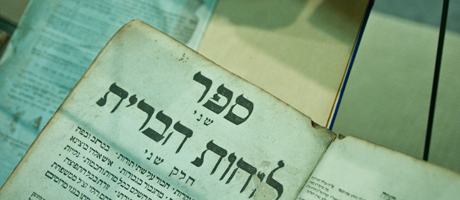By Rachel Muir
A Gelman Library exhibition—on display in the library through January and online indefinitely—charts the course of printing in the territory that is now Ukraine. Through a series of galleries, “Hebrew Printing in Ukraine” showcases 50 religious and secular texts starting with the late 18th century.
“The books displayed in this exhibit, all drawn from GW’s Kiev Collection, are rarely found even in the great research libraries, and most can be found in only a few libraries in North America,” says Brad Sabin Hill, curator of Hebraica and Judaica for Gelman Library’s I. Edward Kiev Collection.
Ukraine—land that came under Polish, Russian, Austrian, Romanian, Czechoslovak, Hungarian, Ottoman and Soviet rule—was “a heartland of the Jewish book,” says Mr. Hill. The first Hebrew printing house in the region was established by a Jew from Amsterdam in 1692. Hebrew printing grew steadily, enjoying a heyday in the late 18th and early 19th centuries as presses cropped up across the region.
The era came to an abrupt halt in 1836 when Hebrew presses were closed by a Tsarist government decree that was not rescinded until 1862. In the late 19th century Hebrew printing experienced a limited renaissance until the Soviet period, when Hebrew was officially supplanted by Yiddish. In the eastern Ukraine region of Carpathian Ruthenia, not part of Soviet Ukraine until after World War II, Hebrew presses continued to function until 1943. Mr. Hill notes that the Holocaust and Soviet repression of Jewish culture ended two and a half centuries of Hebrew printing in Ukraine.
“My favorite pieces in the exhibit are the books printed on blue paper,” says Mr. Hill. “The blue paper was cheaper than better-made white paper and therefore more accessible to indigent wandering printers,” he explains. “So many Hebrew books were printed on this blue or ‘bluish’ paper that it became associated in popular imagination with old Hebrew books. The memory of this paper, which was used in the decades before and after 1800, remained vivid in the minds of writers born in Eastern Europe well into the 20th century.”
Part of GW’s Special Collections Research Center, the Kiev Judaica Collection was established by a donation from the family of I. Edward Kiev, one of the preeminent Judaica librarians of the 20th century. The collection includes works printed over five centuries from around the world, especially Eastern Europe. “GW is fortunate to have such wide-ranging holdings, including Hebrew books from every corner of the globe, which illuminate the history of Hebrew typography, book design, printing and publishing over the course of centuries,” says Mr. Hill.


